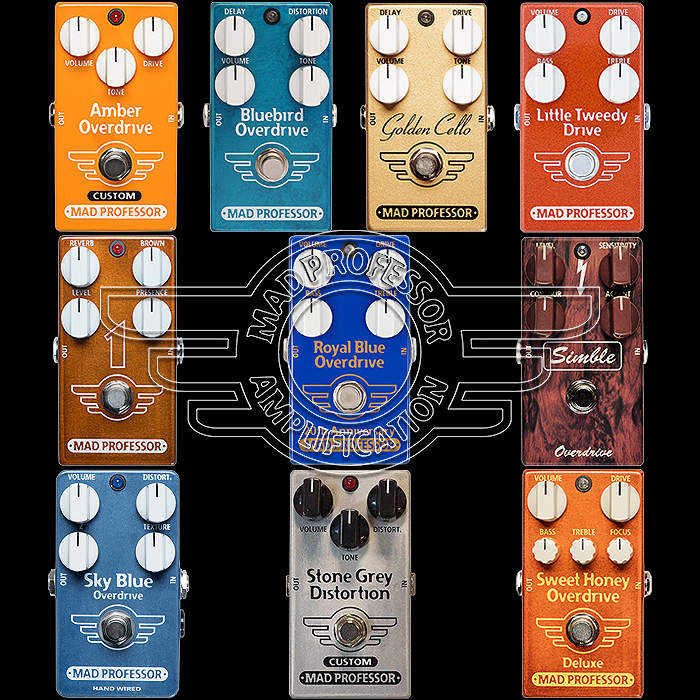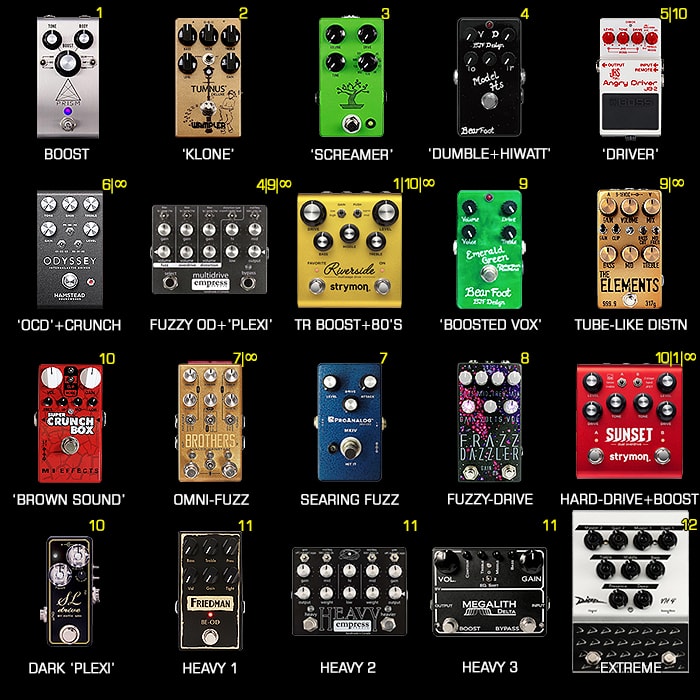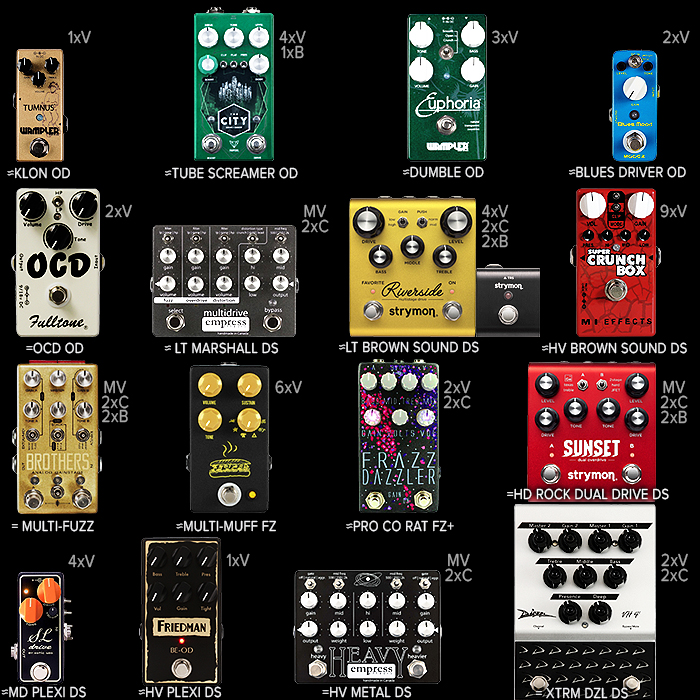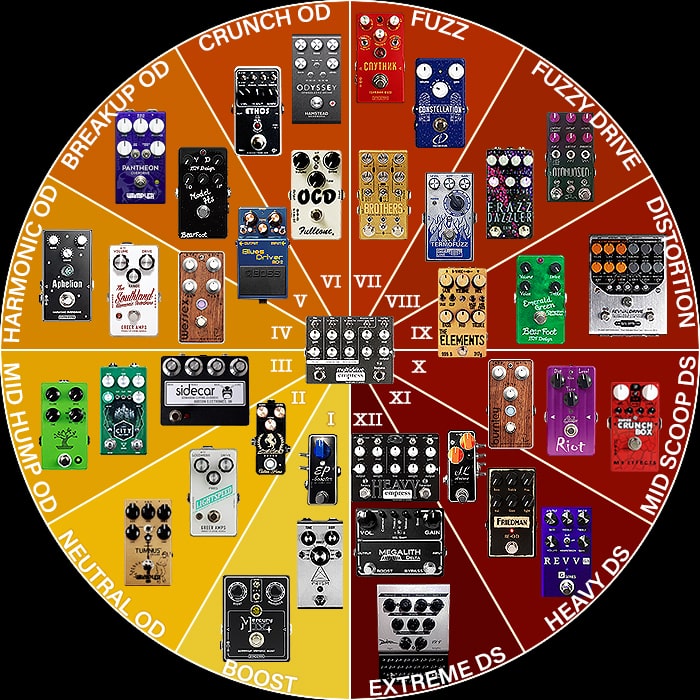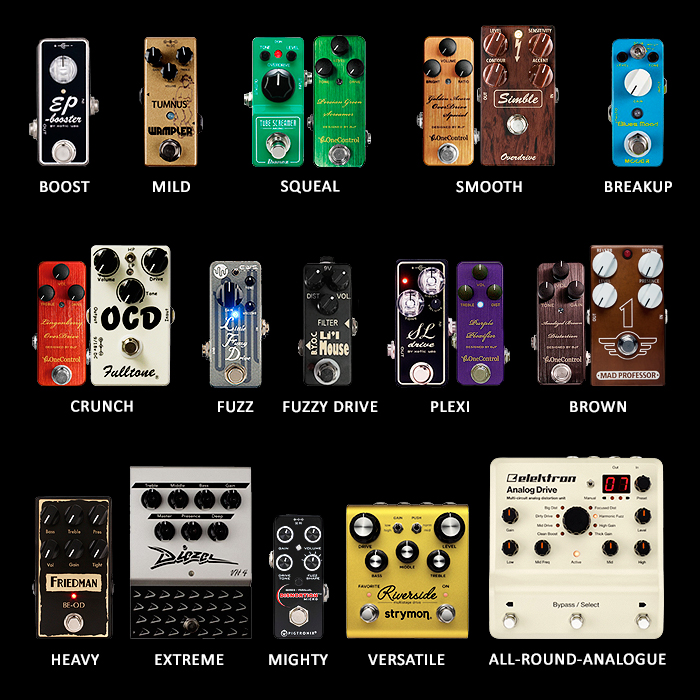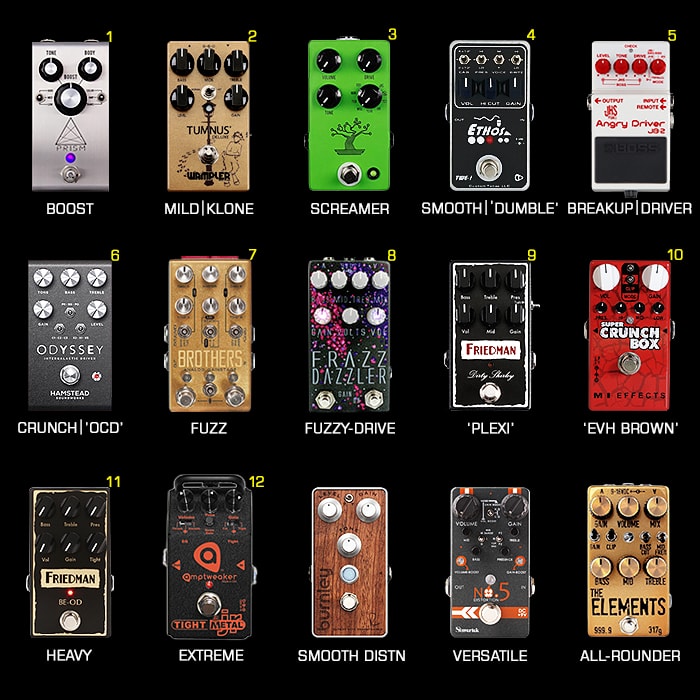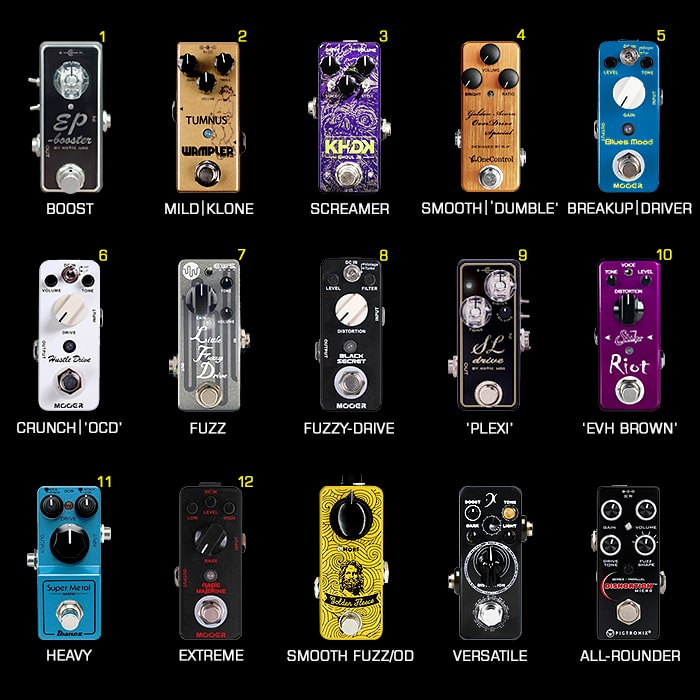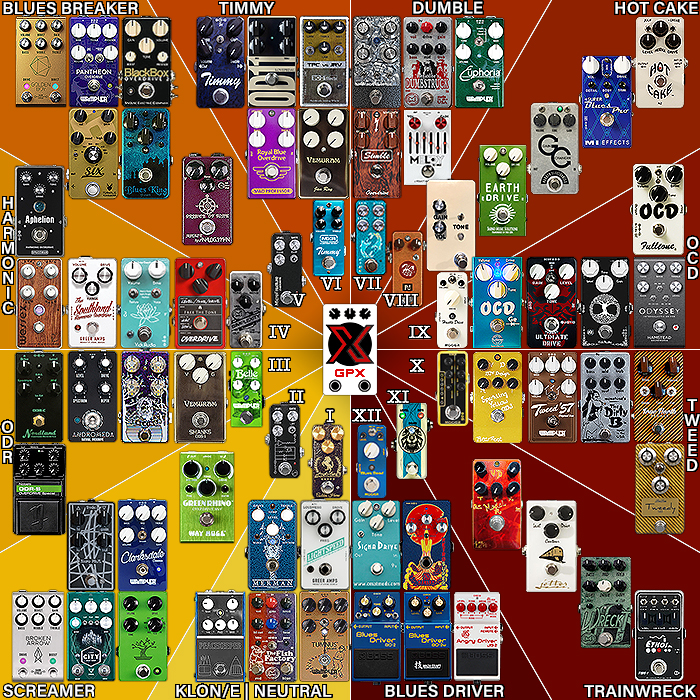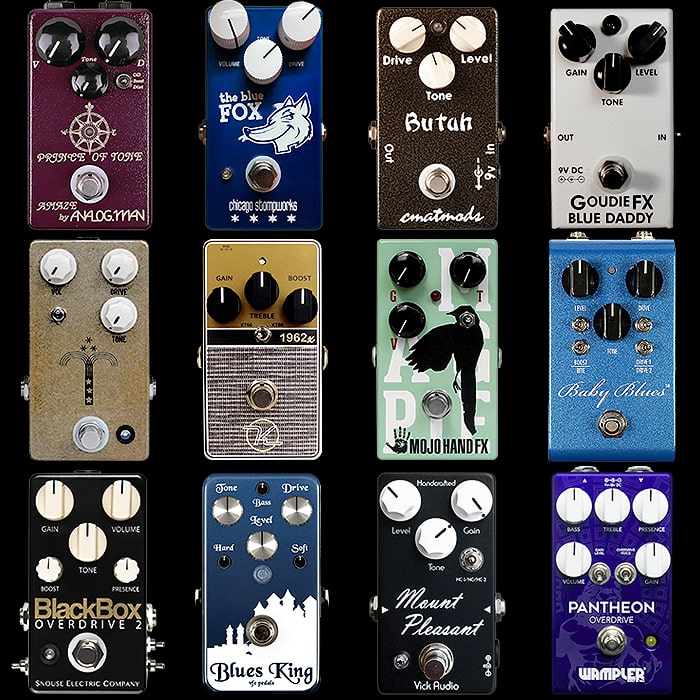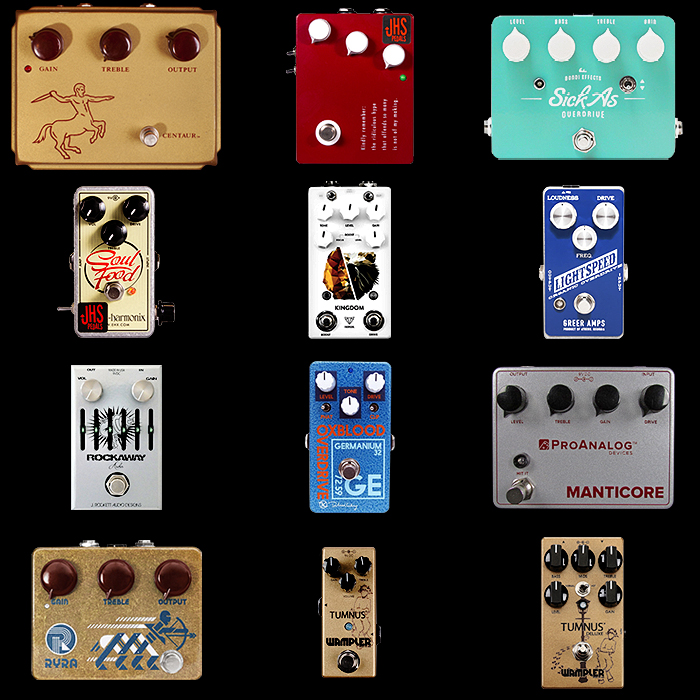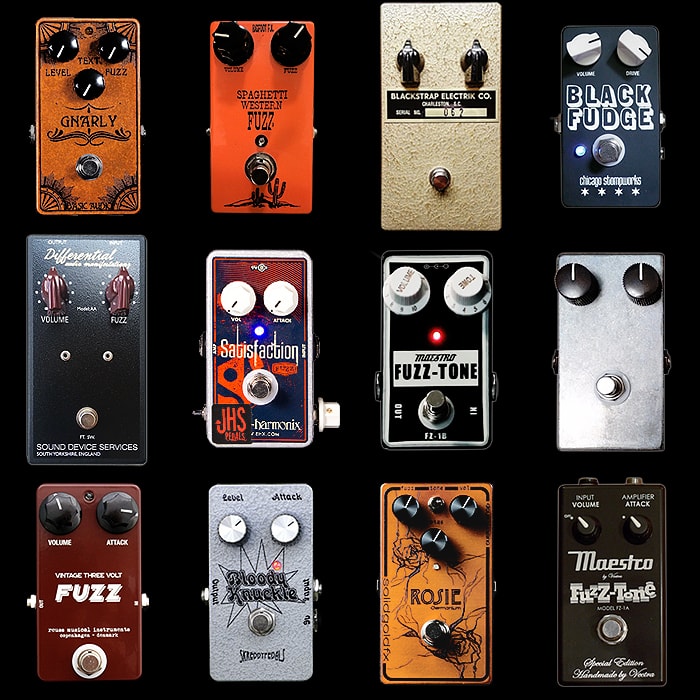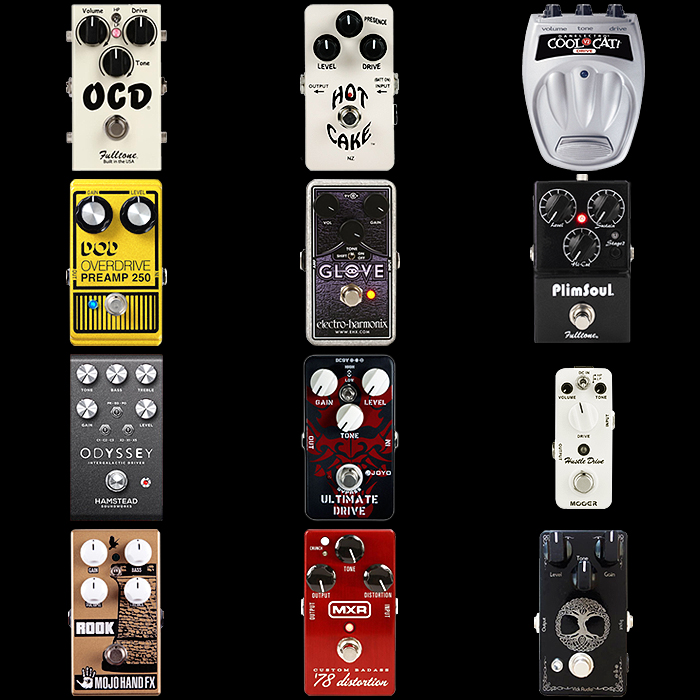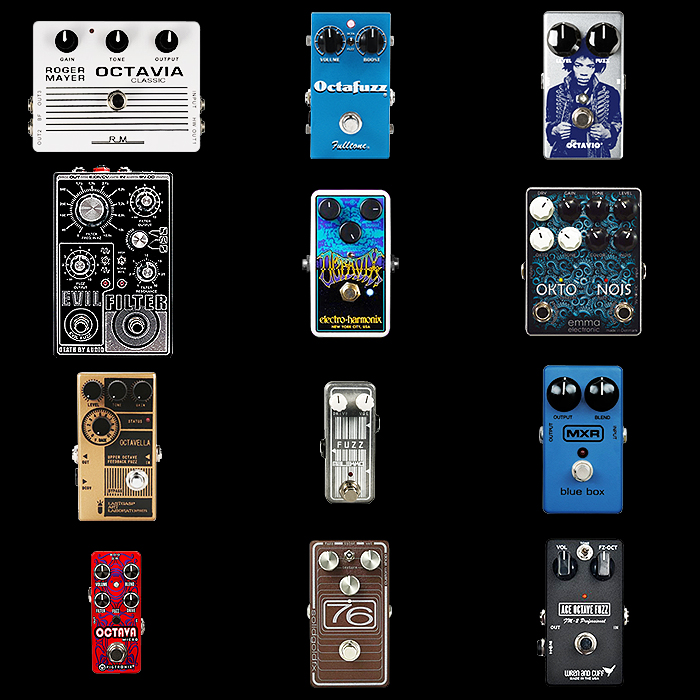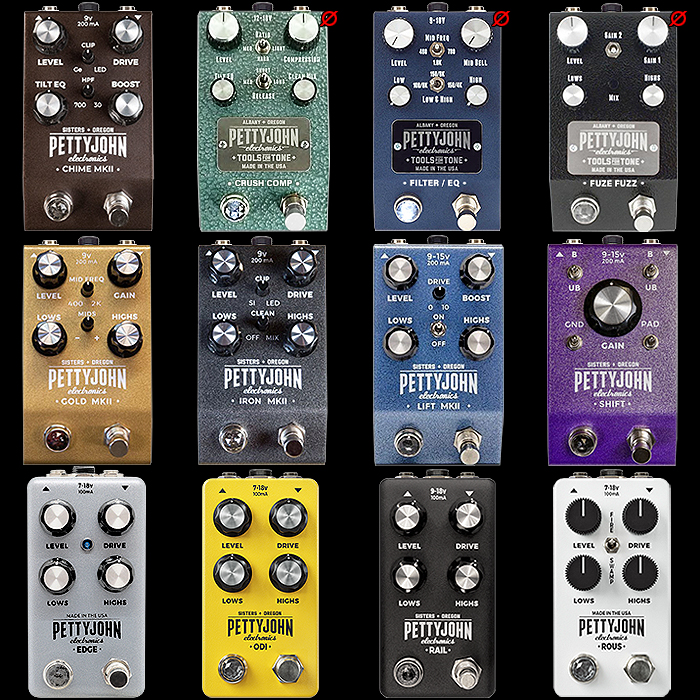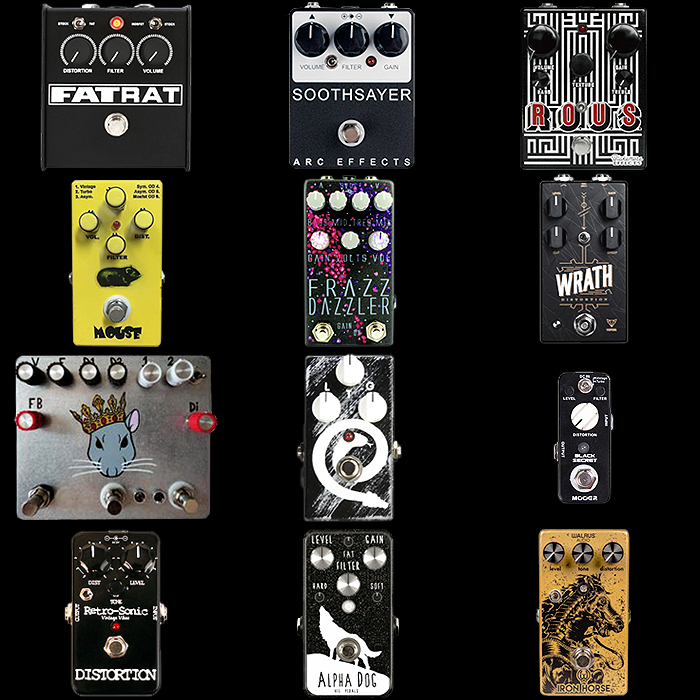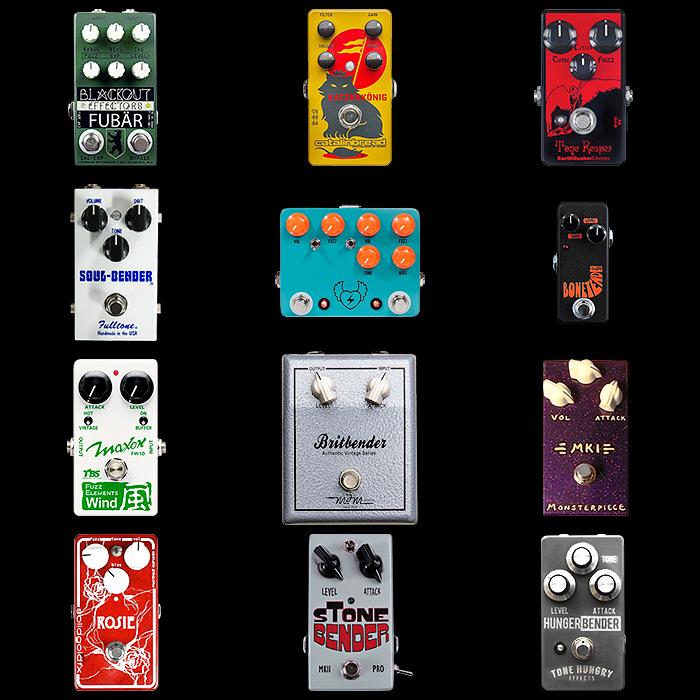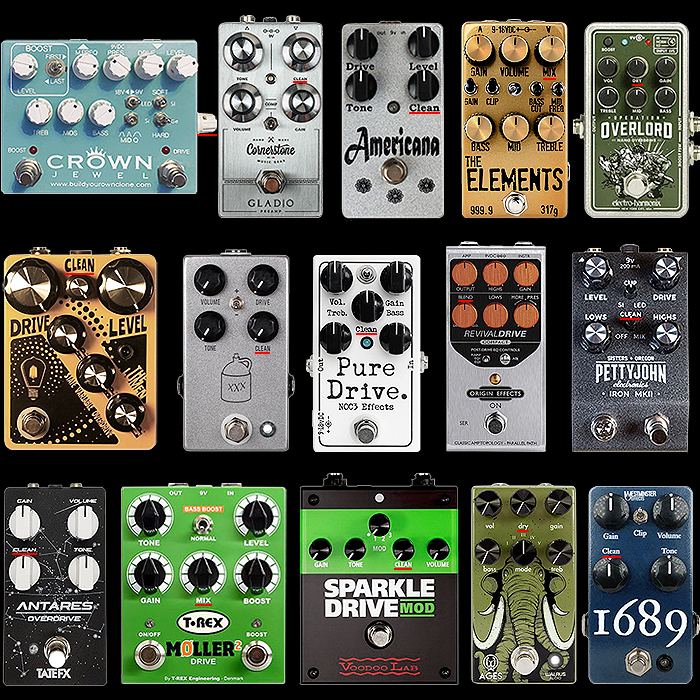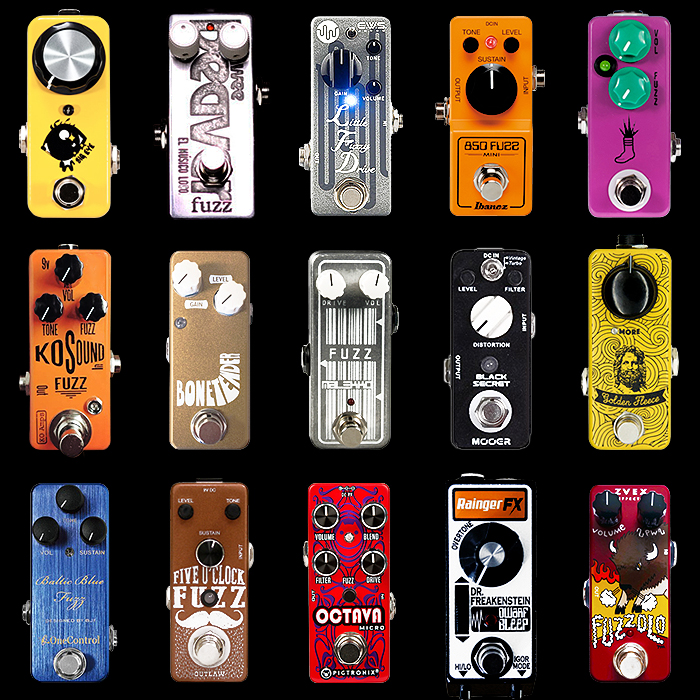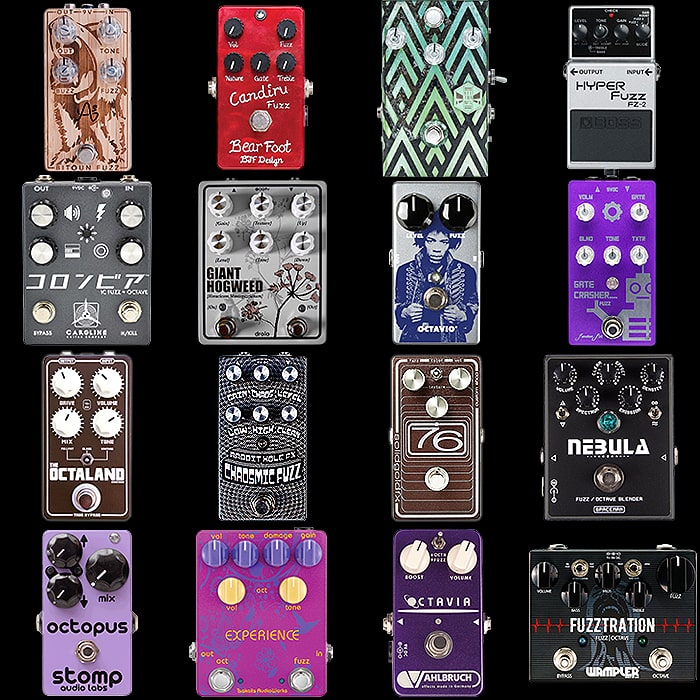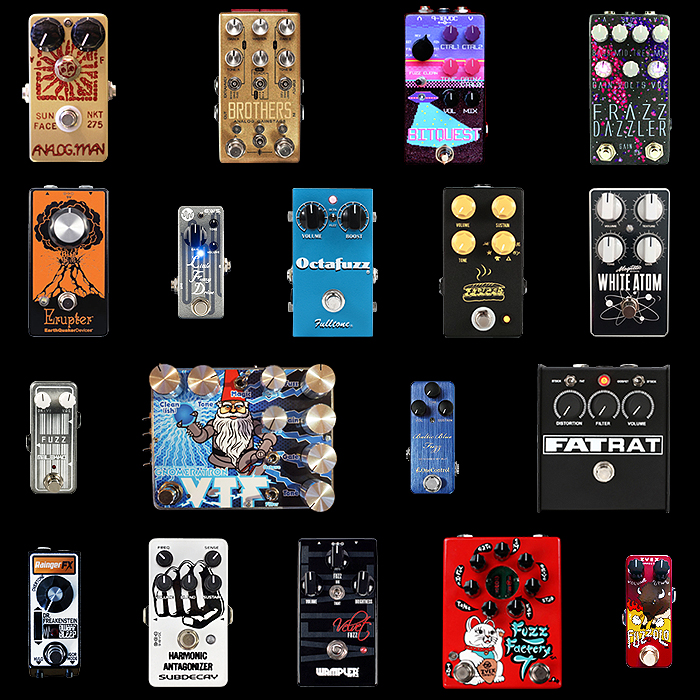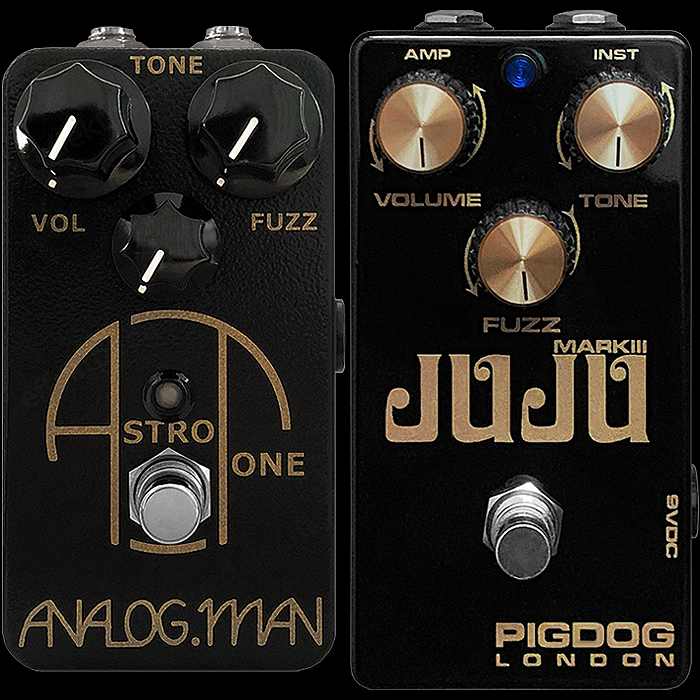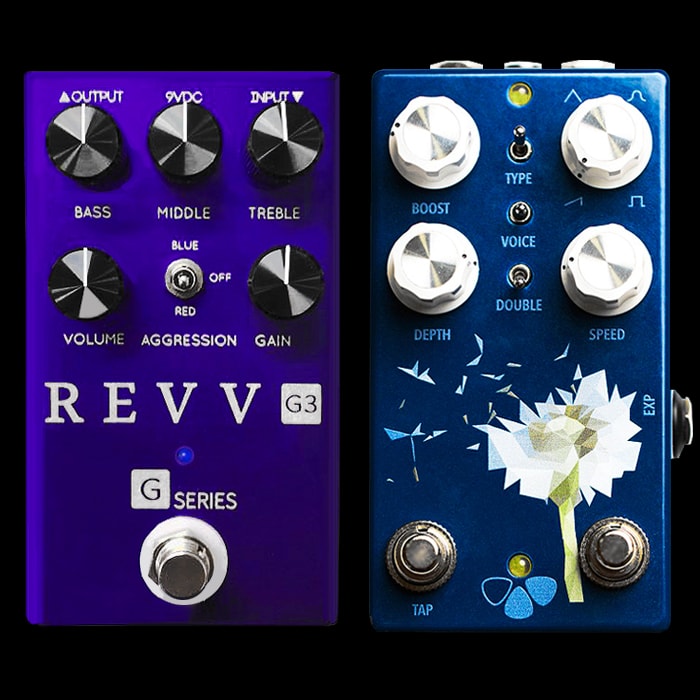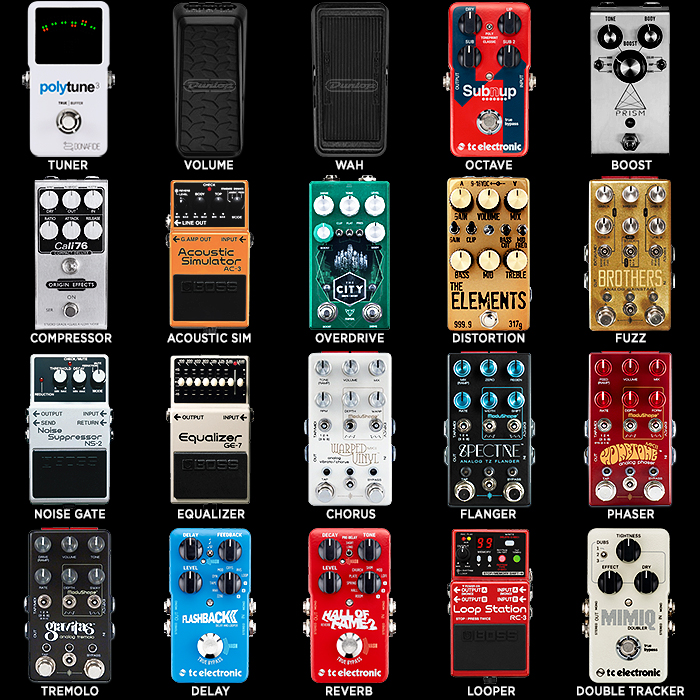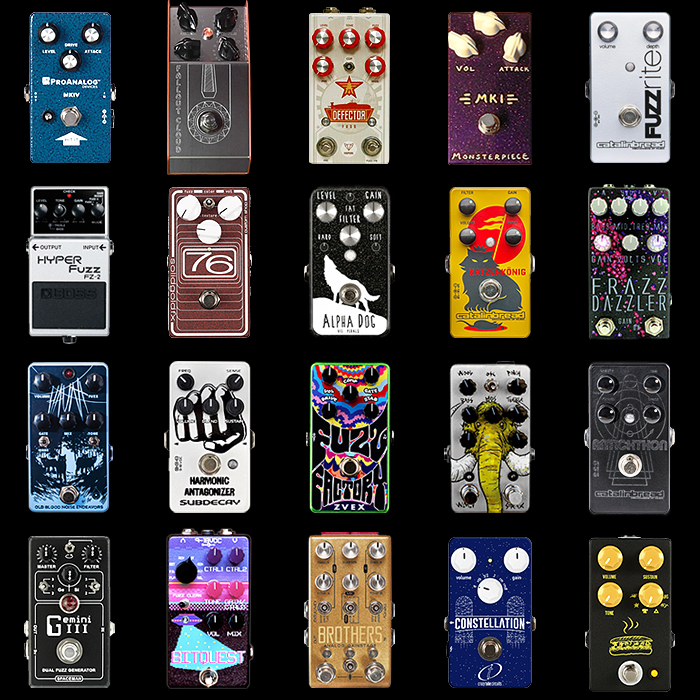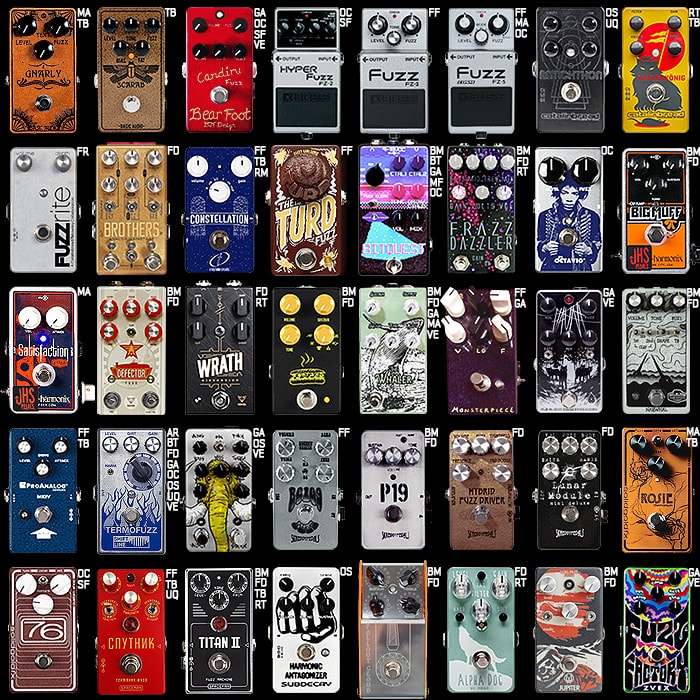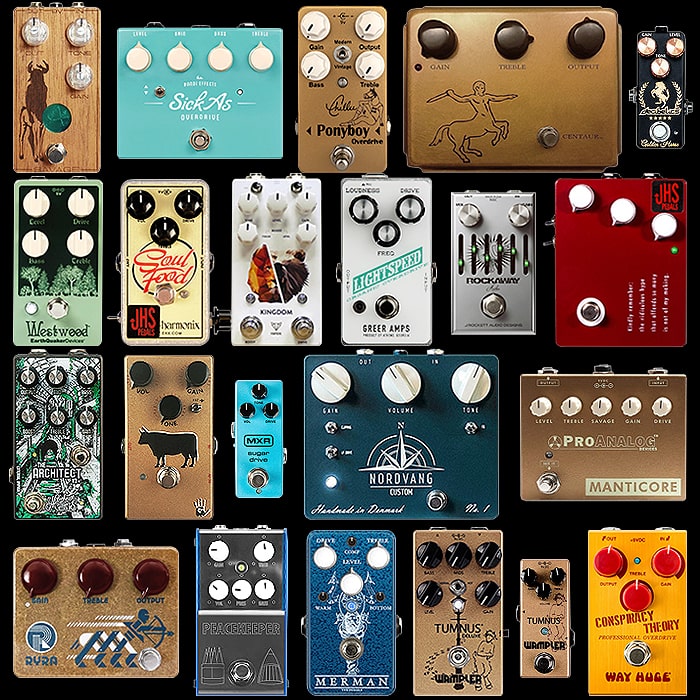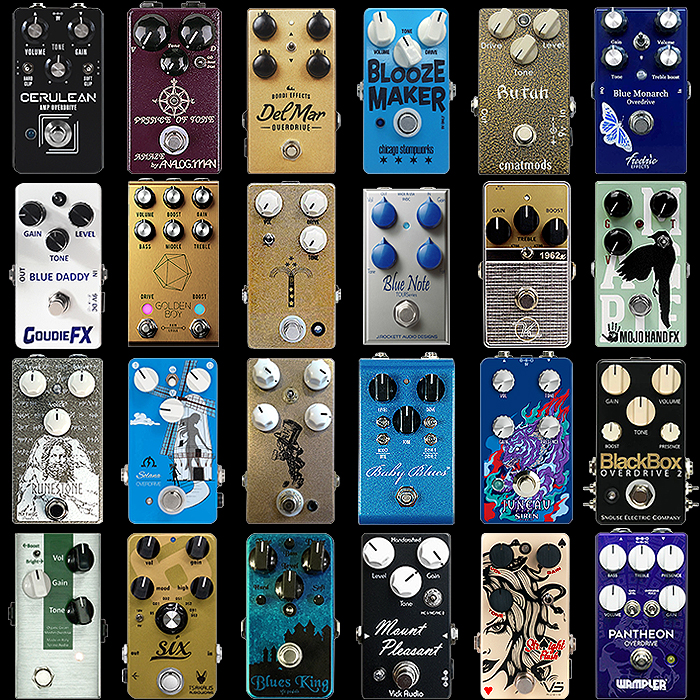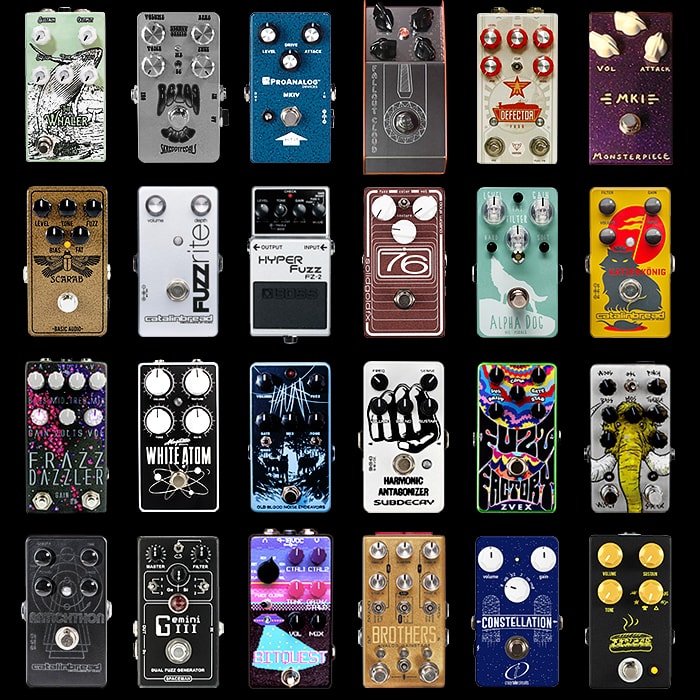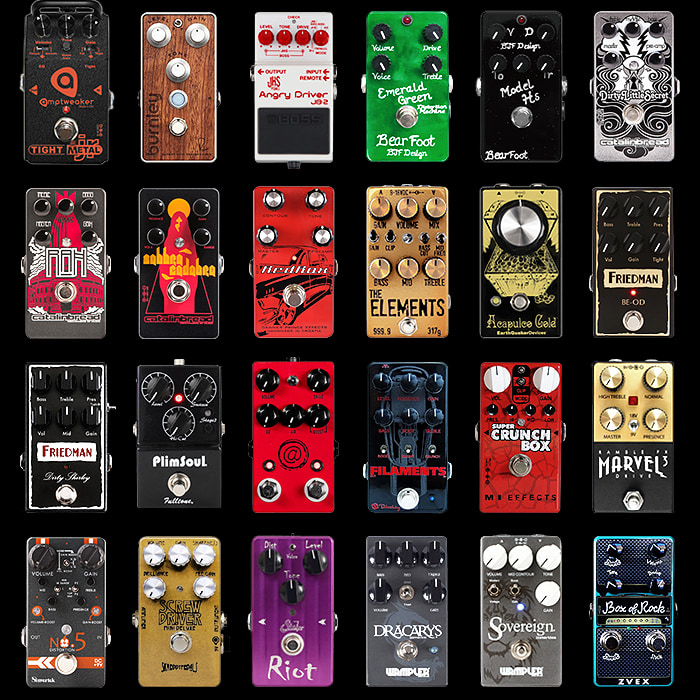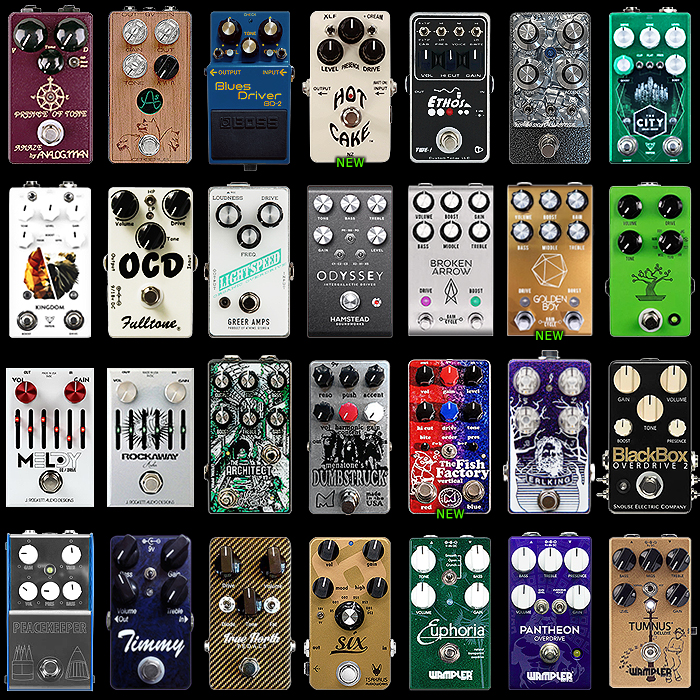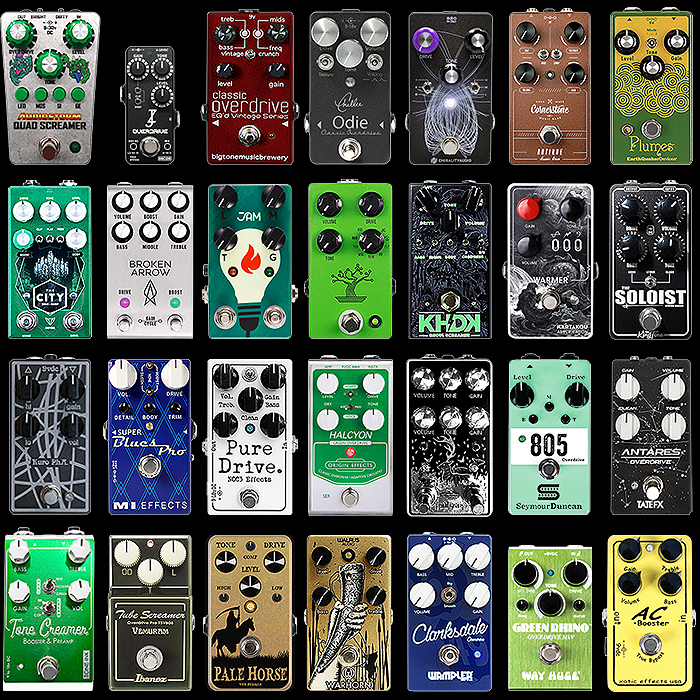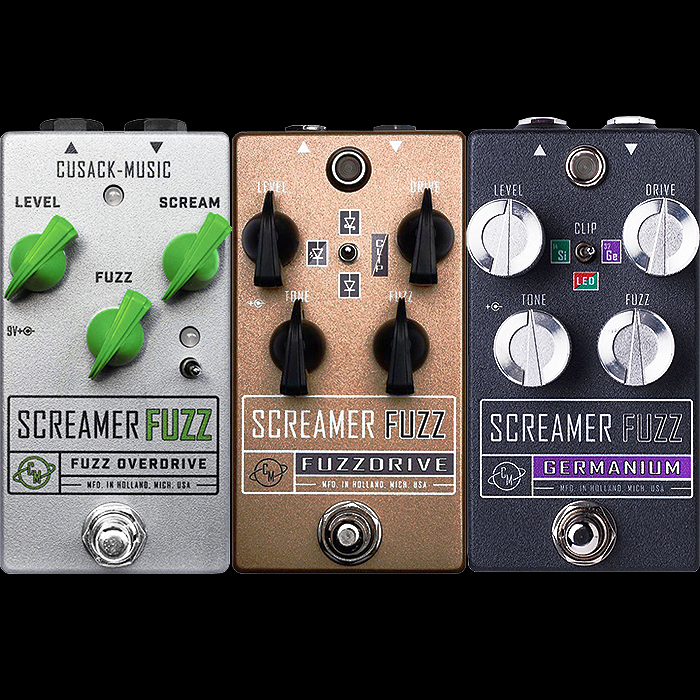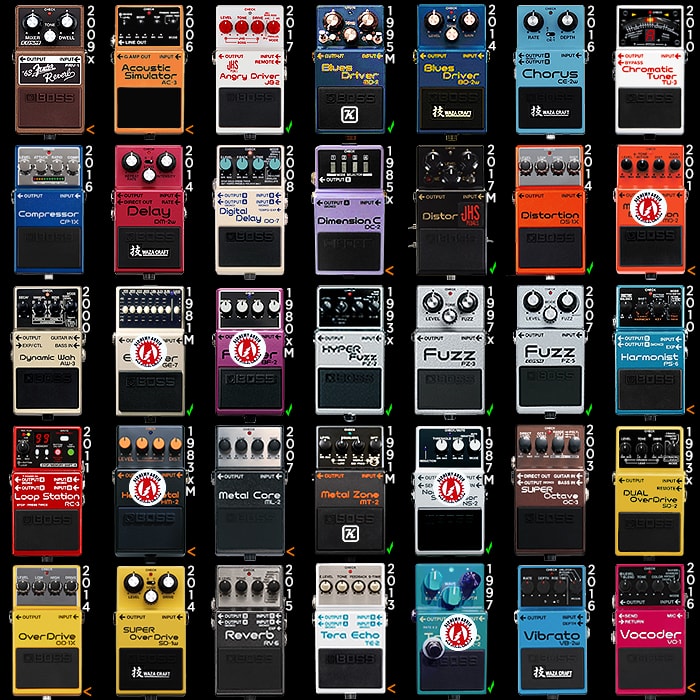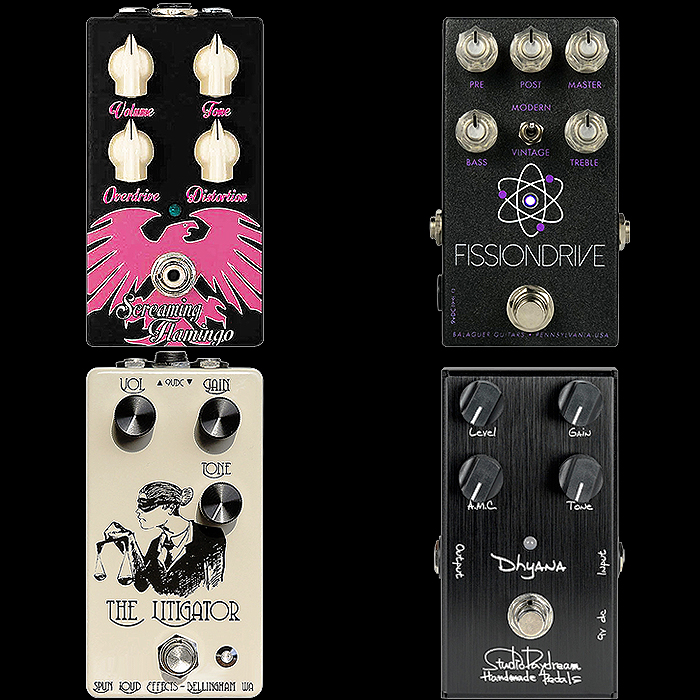24 of the Best Overdrive Pedals - 2018 Compact Edition
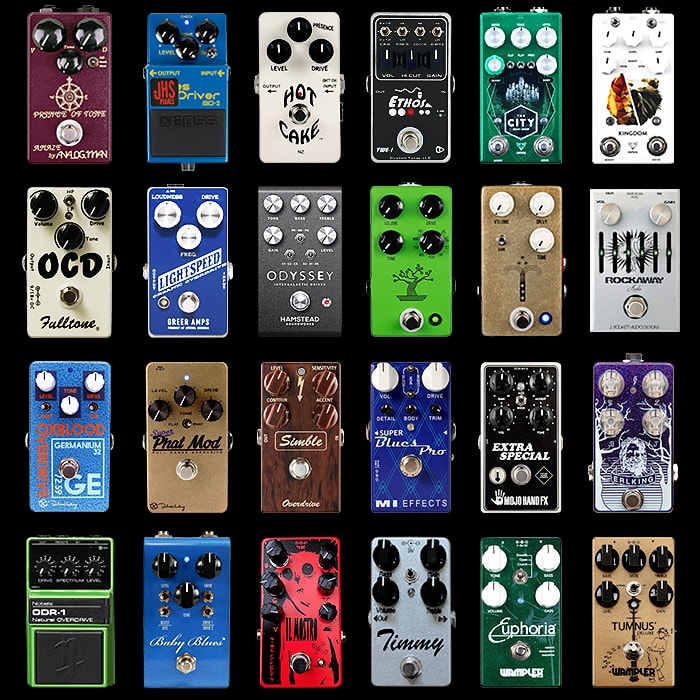
As an update to last year’s piece, and in line with my slightly tighter real estate now (39 pedals), I have decided to go all out on compact format pedals on this occasion. As a subset of my ’12 Degrees of Saturation’ we are dealing with stages 2 to 6 in essence, which largely covers 6 families of overdrives in order of how I set their gain level (increasing amounts) - ’Klon’ type, ’Tubescreamer’, ’Dumble’, ’Blues Driver’, ’Bluesbreaker’, and ’OCD’.
Not all the pedals featured fit neatly into those categories, but there are significant overlaps, and each of these pedals could be listed in a different order depending how much gain you choose to apply. The most populous / popular type here is the transparent / translucent / organic ’Klon-type’ - featuring my current favourite Wampler Tumnus Deluxe, alongside the Foxpedal Kingdom Combo V2, Greer Amps Lightspeed, J Rockett Rockaway Archer and Keeley Oxblood Germanium.
Following JHS’s launch of the 9-separate-analogue-circuit Bonsai Multi-Overdrive pedal, that now becomes the most desirable ’Tubescreamer’ available - seeing as it covers all the classic varieties. I also still love my hugely versatile Foxpedal The City V2 - which I would alternate with the Bonsai as needed. Not included, but worth considering is the now discontinued Bondi Effects Del Mar - which gives you both Tubescreamer and Bluesbreaker voicings via toggle switch - these are in hot demand right now on the second-hand market and are starting to fetch high prices. I also list a Tubescreamer alternative which many love - which is the Nobels ODR-1, and a modern update of that - the Erlking from Mythos Pedals.
My ’Dumble’ category is a little more free-wheeling - featuring the Custom Tones Ethos TWE-1 - which is actually modelled after the cult Trainwreck Express amp, then the Wampler Euphoria, Mad Professor Simble, and Mojo Hand FX Extra Special OD. I also have the Bearfoot FX Model Hs - which features Dumble tones, but I use that more in the Distortion category really (qv).
Next are a few ’Blues Drivers’ - the JHS Blu Drive modded version with extra fuzz flavour toggle - which also produces a richer and more rounded core sound versus the original. Of course my favourite Blues Driver is the recent Boss Angry Driver - whose combination with JHS Angry Charlie circuit again makes it overall more of a distortion pedal, although I mostly use the Blues Driver overdrive circuit. In this same category is the Keeley Super Phat Mod - which is actually Robert Keeley’s evolved version of his own modified ’Fat’ Blues Driver circuit. Finally the MI Audio Super Blues Pro offers a wealth of different clipping options for ultimate blues driver-ish versatility.
A cousin to the Blues Driver is the slightly softer Marshall Bluesbreaker circuit - which is beautifully cloned and upgraded by Analog.Man’s Prince of Tone. JHS follows a similar path with its own take on Bluesbreaker in the shape of its very popular Morning Glory, and the often overlooked RockBox Baby Blues - which has the most versatility of these three via 4 separate voicing toggles.
One step up is the ’OCD’, a pedal which I have always loved and did not expect to be ever bumped - but that was before the Hamstead Odyssey came along with its amazing versatility - giving you great OCD-like tones, plus fuzz and much much more. I’ve sort of included the Crowther Audio Hot Cake alongside these too, as it has a significant overlap with OCD tones - particularly at higher gain settings. The Hot Cake is usually considered its own thing really, but a lot of these pedals have a significant degree of overlap.
That kind of leaves two odd ones out here - the Paul Cochrane Timmy - usually just known as ’The Timmy’ - another classic transparent / organic whatever overdrive - with some degree of overlap with some Klon-types. The Side Effects Il Mostro has a 3-way rotary dial which effectively switches up gain stages - going from barely there to full-on distortion.
The recent trend has seen a lot more voicing toggles and dials on these sorts of overdrives, and a far higher frequency of extended tone stacks - either by way of the usual Marshall 3-band EQ, or the recent J Rockett 6-band EQ.
I could have listed pedals by approximate family, but to avoid controversy have simply listed them out alphabetically - all these are worthy of consideration as far as I’m concerned. I have the TWE-1 on order, and will most likely pick up a Greer Lightspeed, AM Prince of Tone and MI Audio Super Blues Pro next - and probably in that order - oh and I also like the look of hte RockBox Baby Blues and Side Effects Il Mostro - that should round out the collection nicely.
Analog.Man Prince of Tone - $138 (Direct)
The little brother / single footswitch version of the celebrated King of Tone, but with more gain on tap, and all the voicings externalised via a 3-way toggle switch. This has been on my wishlist for a while and I will definitely acquire it some day, just not sure exactly when. This famously is based on the first Marshall Bluesbreaker pedal circuit / sound.
Boss BD-2 Blues Driver JHS Blu Drive Mod - discontinued - C£150 (Reverb.com)
Josh Scott modified the original Blues Driver by reducing the noise floor somewhat, taking the unecessary fizz out of the pedal and giving you a richer and more rounded core sound. The fizz that underlines much of the core tone is then boosted with the additional voicing switch - which gives you a pretty usable fuzz stage. Most of the celebrated modders made their own versions of this pedal, but if I wanted something close to the original - I would most likely get this or Robert Keeley's Fat Mod version - which was cloned in turn for the Mooer Blues Mood - which I also have and love. Generally though, I think anyone who really wants a smart and versatile Blues Drive should be looking as the new Boss JB-2 Angry Driver - which gives you more of everything, and is really more of distortion, but also gives you fantastic excess-noise-reduced core Blues Driver tones.
Crowther Audio Hot Cake - £175
Australian Paul Crowther designed this pedal back in 1976 while touring with his band Split Enz. People variously use is as an organic overdrive or a more driven crunchy distortion - which for me hits similar territory to Fulltone's OCD. Their overall tonal profiles don't exactly match, but they have a significant degree of overlap - particularly in that rich harmonic crunchy tone area. I kind of came to the OCD first, so that became one of my reference tones, but it could just as easily have been this one. It just depends what you're exposed to, and what is readily available I suppose - also the OCD is actually marginally less expensive too, if that's a factor - I really like both - but overall prefer the OCD - particularly as its voicing toggle is external, while for the Hot Cake you need to open it up to switch between Normal and Bluesberry voicings!
Custom Tones Ethos TWE-1 - $225 (Direct)
This is the first ever 'waiting list' pedal I've applied for - and it should be due for delivery March/April - so will feed back on that process when it happens. Custom Tones are best known for their full-featured Dumble-style Ethos PreAmp pedals. The new TWE-1 gets you sort of in the ballpark of that, but is actually modelled on the cult Trainwreck Express amp. There's plenty of tone shaping ability here - albeit by somewhat strange means and not at all the usual 3-band tone-stack, but instead a series of 3 dials and 4 voicing toggles which allow you to target certain frequencies and ramp up the gain stages. I will be using this in my 'Dumble' pedal-chain slot, as I feel there is a significant degree of overlap here, although the Dumble and Trainwreck are of course 2 distinct amps.
Foxpedal The City V2 - £223
I'm a huge fan of Todd Billow's Foxpedal brand, but strange things are definitely afoot - as the website and all social media disappeared near the tail end of last year, and then bizarrely re-appeared just after NAMM. Notices on said site say something about re-stock / deliveries resuming in April - so I assume it's all back to business as normal. In any case I have 4 Foxpedals - including this excellent take on a Tubescreamer - featuring a second independent footswitchable Ebenezer clean boost, and a a series of 5 dials and 3 tone-shaping toggles which allow you to smooth out the mid-hump, select different clipping stages and really sculpt the core sound do a very significant degree. This has long been my favourite 'Tubescreamer' type, but looks like it will be partially bumped at least by the new JHS Bonzai - which has less tone-shaping, but gives you a lot more core flavours.
Foxpedal Kingdom Combo V2 - £223
Todd Billow's take on the Klon circuit is along similar lines to The City V2 i.e. a number of additional voicing options - but it derives a lot of its versatility through its smart frequency-tuneable boost switch. The independent boost has a wide frequency sweep so you can either bump the bass or mids, or use it as a treble booster. We have 2 voicing toggles - both which are just on/off - the first 'OD' is a soft clipping to the feedback path of the IC, allowing for earlier and smoother breakup, the second 'Clip' toggle varies the hard-clipping applied to the circuit - for more or less 'grit'. This is a great sounding pedal, but gets pipped by the Wampler Tumnus Deluxe whose overall tone profile I prefer. That said - the Tumnus does not have that super useful independent boost which can change things up quite dramatically - giving you near enough two-channel functionality. Note that above video shows the older larger version, there are currently no demo videos of the newer compact model pictured above.
Fulltone OCD - £149
For the longest time this was my favourite 'crunch' pedal - which delivers incredibly rich and complex medium distortion harmonics with High Peak and Low Peak voicing toggle to give you softer or harder (more gain) overdrive - I've always been more of an HP type of player. I never though this pedal would be bumped from its prime position, but then along came the Hamstead Odyssey which allows you to approximate the sound of the OCD and gives you way more in terms of voicing options - far greater range including fuzz voicings. That said, the OCD is less expensive and is a bonafide classic beloved by most. There is some interesting overlap in tone profile between the OCD and Crowther Hot Cake - as far as my ears tell me. I would say though that for versatility the Hamsteead Odyssey has them both beat - however exceptional they both individually are.
Greer Amps Lightspeed - £199
This is probably my favourite overdrive that I don't have yet - Peter Honoré and That Pedal Show are huge fans of this organic / natural sounding overdrive - which I naturally associate with the Klon-style of pedal - albeit this particular circuit pays no allegiance to that. It nevertheless sounds beautifully warm, rounded and incredibly dynamic. It does not have the extended tone stacks of some of the contemporary Klones, but it gets the maximum out of its standard 3 dials. This is just a glorious sounding overdrive no more needs to be said.
Hamstead Odyssey Intergalactic Driver - £219
I was fortunate enough to get a first edition of this one - which was surprise-released just before Christmas. Like many others I was bowled over by the That Pedal Show demo. The five dials are not your typical mix here as we have Bass & Treble controls, but then a Gain Tone dial to go with Gain and Level controls. So no Mids control per say - which I would have liked, but you can approximate mid controls by playing the Tone Dial off the Bass and Treble. The real magic here are 3 different 3-way toggles, on of which is a gain multiplier, then pre/post EQ control - or you can select to use the pedal just as an EQ. Finally you have clipping toggle which gives you a really broad variety of tones - from the lightest of overdrives, through fuzz and onto pretty heavy distortion. There are very few overdrive pedals that are as versatile as this. Moreover it features the OptoKick footswitch from Daniel Steinhardt's TheGigRig2 - which is easily the best of its type - an all-round killer package. This pedal took over the OCD slot in my pedal chain - and it can easily cover those tones and a whole heap more.
JHS Bonsai Multi-Overdrive - £219
This is the most likely best seller for 2018 - due to hit UK retail on March 3rd. Josh Scott combines 9 classic analog Tubescreamer circuits within a single enclosure - the Boss OD-1, TS808, TS9, Metal Screamer, TS10, Exar OD-1, TS7, TS808 Keeley Mod, TS9 JHS Mod. Any lover of Tubescreamers will be delighted to get all the classics in a single box. I already have and really love Josh's Big Muff Muffuletta equivalent, so there seems to be a trend developing here. There is no longer any need to deliberate whether you prefer the TS808 or TS9 version pedal - here you can have all the key TS flavours at your disposal - what's not to like!
JHS Morning Glory V4 - £159
JHS's much loved Morning Glory is based on the Marshall Bluesbreaker circuit with additional toggle for added gain stage, as well as a side-switch for Hi / Brightness Cut - otherwise just the standard 3 dials. Another great open and natural / organic sounding pedals - you really are spoilt for choice here as all of these sound fantastic - it's just down to your own personal choice of tone and timbre. There is of course some degree of overlap, but all these pedals have their own discernible identities too.
J Rockett Rockaway Archer - £249
The most recent of J Rockett's / JRAD's Archer series also happens to be a Steve Stevens signature pedal. Instead of the traditional 3-dial configuration we have the typical Volume and Gain dials, but then a 6-band EQ which gives you the most incredible of tone-shaping options. Before the surprise announcement of the Wampler Tumnus Deluxe, this was at the top of my Klone wishlist - I still kind of want one of these, but feel it would always play second fiddle to the Tumnus.
Keeley Oxblood Germanium - £219
Both the Oxblood original and Germanium are great Klone pedals and in that sort of advanced or deluxe mode. Even though the dials and toggles are labelled somewhat differently to the Tumnus Deluxe you get similar control nevertheless over the key frequencies. The Germanium version gives you slightly more dynamic, warmer and open tones - but both versions are great. When the That Pedal Show featured a bunch of different Klones, it was different really to decide which was genuinely 'the best' as all sounded amazing. The mini Tumnus was my favourite for so long, that it made sense for me to upgrade to the Deluxe - so that's how things stand at the moment. The Keeley Oxblood though is well worth consideration.
Keeley Super Phat Mod - £149
Mike Piera, Josh Scott, Robert Keeley et al - all cut their teeth on modifying Boss Blues Driver Pedals - notable Robert's 'Fat Mod' was one of the most popular Blues Drivers out there. In the Super Phat Mod - Robert has engineered his own pedal to deliver the same sort of sound as his original mod - obviously now a little more evolved from that. For a long time the Mooer Blues Mood was my favourite Blues Driver pedal - itself actually modelled on Robert's original Blues Driver Fat Mod! A really great Blues Driver style pedal - with some of the rougher edges tidied away as such.
Mad Professor Simble - £149
My original preferred Dumble-style pedal where I could really dial my favourite Dumble tone in with ease - yet that pedal does not have a huge range - it does though have a more even and full-frequency profile than the Lovepedal Hermida Zendrive which always sounds a little anaemic to me. In my final shootout it was between the Simble and the J Rockett Dude - where I felt the Simble just about had a slight edge, but there really was not much it it. I latterly updated to the Wampler Euphoria - which with its 3-way voicing toggle has a far greater range than the Simble, but for which it took longer to actually dial in my perfect tone.
MI Audio Super Blues Pro - £137
I love Michael Ibrahim's pedals and already have the Super Crunch and Megalith Delta and really want to add both this Blues-Driver+ and Cross-Over Overdrive pedals. The magic on this pedal is dual 3-way voicing switches which allow you to add Silicon and Mosfet clipping independently and in parallel. You have the usual Volume and Drive dials, and then 3 smaller dials - Detail, Body and Trim which sort of give you a type of 3-band EQ. A super-versatile pedal which is not really a Blues Driver but can cover a lot of the same territory.
Mojo Hand FX Extra Special - £179
One of two different Dumble-style pedals made by Mojo Hand FX where the other one is the DMBL. The Extra Special kind of super-charges the original and provides more of the medium to high gain flavours of the Dumble. Dial and toggle layout is identical - it's just the gain stage that is voiced a little differently. My favourite thing about the Dumble sound is that really smooth fuzz-edged overdrive - not quite Mad Professor's Golden Cello, but very slightly touching on that territory.
Mythos Pedals Erlking Overdrive - £199
The Erlking goes one better than the original Nobels ODR-1 which it is based on - adding a Bass control dial to the original trio of Gain, Level and Tone - allowing you to more easily tune the pedal to your rig. Think of this as a modern update to the Nobels, which has largely been considered as a really decent alternative to the Tubescreamer - it's a slightly different circuit, but with significant degrees of overlap. Nashville guitarists love the Nobels, and you might consider this one step up from that.
Nobels ODR-1 - £85
Easily the most affordable pedal featured here, this is a bonafide classic in its own right and much beloved of Nashville chicken-picking guitarists in particular. It's usually associated with the Tubescreamer as there are significant degrees of overlap here - but the ODR-1 is its own circuit. Some of you may prefer its core tone and timbre to any of the various Tubescreamers already out there. I'd quite like to add a Nobels for occasional swap-out - we'll see how that goes.
RockBox Baby Blues - c£100 (Reverb.com)
Another pedal based on the Marshall Bluesbreaker, but with a little more up its sleeve than most. It features 4 individual voicing toggles - Boost | Bite | Drive 1 | Drive 2 - which you can deploy individually or stack together. It's in similar territory to the Analog.Man Prince of Tone and JHS Morning Glory, but with a few more tone-shaping options. It's relatively affordable and would be a decent way to acquire the Bluesbreaker tonality, although I may overall prefer to acquire a Prince of Tone - both are highly viable though.
Side Effects Il Mostro Triple Drive - c£90 (Reverb.com)
I have and love Side Effects homage to the Zvex Woolly Mammoth 7. With the Il Mostro the brief was to create the most versatile drive pedal possible - with a 3-way voicing / clipping rotary dial which ramps up the gain stage from low/mid overdrive to full on beast-mode. We have 3-band active EQ and the usual Volume and Gain dials too. Shane Diiorio does a great demo of this pedal - sounds really great and at a great price.
The Timmy (Paul Cochrane) - £180
It's funny how pedals evolve - you have the King of Tone and Prince of Tone - with the former still probably the more popular with its additional boost footswitch / side. While for Paul Cochrane's pedals it started with the larger Tim pedal - with additional boost switch etc. but the smaller Timmy became more popular. It's along similar lines to a Klon but has separate Bass and Treble controls - which work more as High and Low Pass filters. You then have a 3-way voicing toggle which gives you an extended range of gain profiles. This is not really a Klon-type - it's more its own circuit really - especially with how it works - and it has a slightly different tone profile overall - even though it does sit within that general organic / transparent overdrive category.
Wampler Euphoria - £179
The second of my Dumble-style pedals - this pushed the Simble aside by virtue of its greater range and versatility. I currently have the Bearfoot FX Model Hs in this slot, but will then temporarily swap that out for the Skreddy Screwdriver Mini Deluxe, before ending on the Custom Tones Ethos TWE-1 which I am due to receive in March or April! The Euphoria has a 3-way voicing toggle which gives you an extended range of tones, but beware of how you use the Bass dial - which is a sort of combination of Bass and Body and should be used very sparingly - and rarely if ever at 12 o'clock or above. For my tastes it hovers around 9 o'clock. It took me a while to get the sense of this pedal as I originally struggled to dial in my perfect tone - largely owing to a misunderstanding of how the 'Bass' dial worked. I still feel that I've achieved my best / most ideal Dumble-style tone on the Simble, although I can get very close on the Euphoria now, with plenty of other options on tap additionally.
Wampler Tumnus Deluxe - £189
I really love the original mini Tumnus, but this bigger brother - with full 3-band EQ and added hot-mode toggle switch is better in every respect. The original was probably already my favourite and most-used overdrive and this one will be even more so. The core Tumnus tone really improves on the typical Klon profile by enhancing the frequency range - particularly in the lower register. This pedal just sounds wonderfully warm and rich and open sounding. If I was forced to have only one overdrive than this would likely be my choice. If I wanted slightly more variety I would add the Hamstead Odyssey and JHS Bonzai - for the widest possible overdrive tonal palette - I can't see any other 3 pedal combination that would outdo that! But I would probably want a Blues Driver and Dumble pedal somewhere in there too...
Final Thoughts
There's often a question circulating about how many transparent overdrives can you tolerate. The truth is really that there is no absolute transparency as such in overdrive - each of these is a flavour enhancer as such, it just depends on how close to neutral you like it, or if you prefer slight accentuation in certain frequency bands.
For my own self I can accurately distinguish the key tonal families here to a degree - certainly within my pedal chain - as I have them all as distinct flavours. In terms of universal comparisons though it's much harder and can be difficult to distinguish actually which pedal you are listening too. There are of course other important ingredients in the mix - you guitar, amp, booster and other elements to the rig - all of these matter and each overdrive pedal will react slightly differently as a flavour enhancer to whatever core tone you have established - so you may get varying results across the range of pedals - so that of course is an important consideration.
You certainly don't need all these different levels of saturation or tonality, and many don't like the mid-hump profile or boosted bottom end. I really don't like profiles that are too flat and anaemic - that is in part because I play entirely at home, and mostly entirely solo - so that is a factor too. Within a band frequency mix - if you are overlapping key frequencies of other instruments you will just make your sound muddy, while when solo - you want as rich and as broad a profile as possible. Then there are also those that prefer those flatter profiles - the raw Klons and Zendrives - while I like a touch more seasoning / flavour.
My favourite pedal here is the Tumnus Deluxe, then the Bonzai and then the Odyssey probably. I've also mentioned I would like to add a Bluesbreaker into the mix - which I don't currently have - either a Prince of Tone or Baby Blues - and the Greer Lightspeed is probably my favourite overdrive I don't have yet - finally I really like the Il Mostro, and may decide to go for a Nobels ODR-1 or Erlking at some stage, but really in no great hurry - I have plenty of flavours to play with already.



















